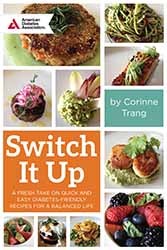
Corrine Trang
Corinne Trang is a former editor of Saveur magazine turned cookbook author. We caught up with her to talk about her latest cookbook, Switch It Up, which she wrote in partnership with the American Diabetes Association, and the importance of balance and diversity in your diet.
Tell us about yourself.
In the 1990s, I was as an editor at Saveur magazine. A friend encouraged me to branch out with my cooking, so one thing led to another and I wrote my first cookbook in 1999. Nine books later, I’m still writing cookbooks, as well as taking on various teaching and lecture opportunities to talk about current food trends.
What is your philosophy with cooking?
I see food as a healing art. I focus a lot on Asian-style cooking, like Chinese and Indian, as well as Ayurvedic. Eastern food philosophies are centered around food as a healing art, so this is what led me eventually to apply Asian cooking principles to any kind of cooking. My new cookbook is not solely Asian-focused, but the message I want to convey is how to incorporate healthy elements of cooking, many of which are Eastern philosophies, and make it easy to cook at home.
Variety is important. If you eat the same thing, you’re not developing your palate. You won’t understand balance or health, because having a healthy diet and lifestyle requires variety. You can’t eat roast chicken and broccoli every day. The more exciting the meal, the more you’re engaged in trying new ideas.
I’ve heard you use the term “architecture” when it comes to cooking. Can you elaborate on this?
Whether it’s Western, European or Asian, there is an architecture to cooking. For example, in Chinese cooking when you use a wok, you typically use grape seed or peanut oil. In Italian cooking, you use a skillet with olive oil. Chinese recipes often incorporate rice noodles, while Italian recipes use pasta. To season, you typically use soy sauce for Chinese, salt for Italian.
Cooking any style is an identical structure or “architecture,” it’s just a matter of using different pantry items. But the one guiding principle I stress is to always include lots of veggies; that’s where the balance comes in. I advise that 70-75 percent of your diet should be green and plant-based, followed by protein, then carbs.
 How did you come up with the idea for your new book?
How did you come up with the idea for your new book?
In my new book, I wanted to make recipes fun and easy, with easily accessible ingredients, and teach good structure and principles of healthy cooking. I also wanted to create a resource to make meal planning and putting balanced meals together easier for people. This is a goal of the American Diabetes Association.
We have to start thinking that way. All too often, we just grab a meal or quickly make a meal, but don’t think about all of the elements. For example, you’re going to eat pasta and meatballs, but where are the greens? How do you bring some balance to this meal? Why not sauté some greens? Incorporate peas. Or make a big salad.
The idea with Switch It Up is how you can easily mix and match recipes to create different meals. There are only 50 core recipes in the book, but the combination possibilities are endless. For many people, when you have a cookbook with 1,000 recipes, how many of us are actually going to cook every single recipe? What we do is flip through, hone in on favorites and make those over and over. I love the art of the word, but often times there is so much text and writing and people only have so much time to dedicate to food. I wish we all had more time.
This book is written in partnership with the American Diabetes Association. But it seems that anyone can benefit from reading and using it.
What’s healthy for someone with a health condition is healthy for everyone. And healthy food doesn’t have to be boring. We all should be more conscious about the amount of sugar and salt we consume, and to control portions. I have several friends with diabetes. I’ve always been interested in anything that is related to food and health, whether it’s diabetes or cancer-preventative foods.
What are some of your go-to ingredients?
For an Asian kitchen: soy sauce, rice vinegar, grape seed oil and dark sesame (toasted) oil as a finishing oil, not for cooking. In my fridge: ginger, garlic and scallions. These are aromatics. When I cook Japanese, I remove the garlic. In Asian culture, sugar is used a bit to balance the saltiness. Additionally, I like to have a little bit of spice, like chili sauce.
Try one of Corinne’s recipes from Switch It Up: Curry Shrimp with Peas.
Switch It Up is available at ShopDiabetes.org, in bookstores nationwide or by calling 1-800-232-6733.


 How did you come up with the idea for your new book?
How did you come up with the idea for your new book?